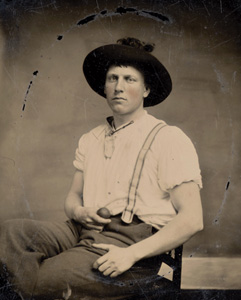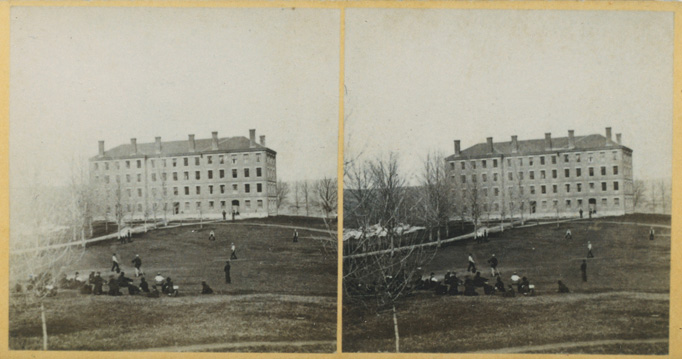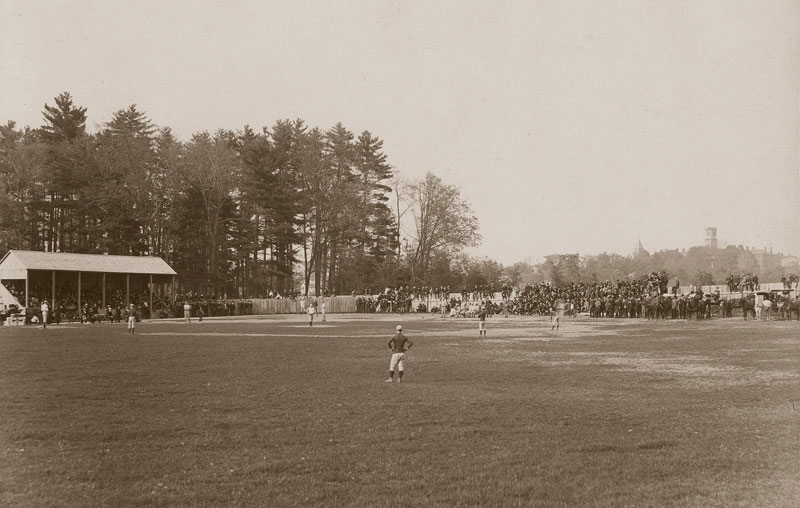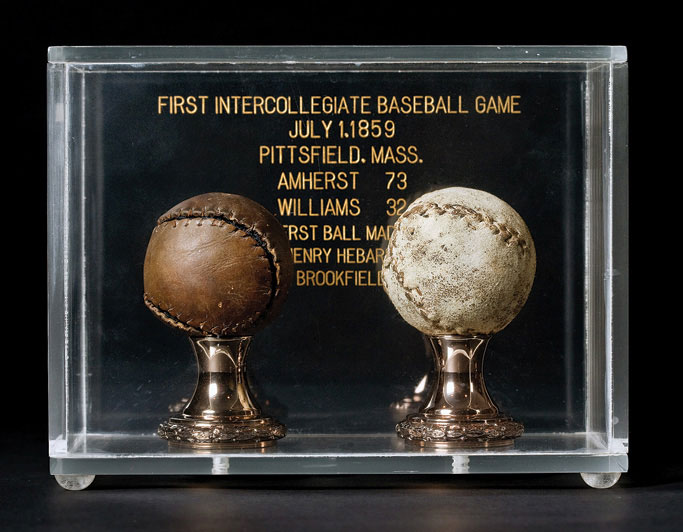By 1859, baseball in very rudimentary form was about a quarter-century old. The first official uniforms had appeared only 13 years earlier. Two sets of rules vied for acceptance: “Massachusetts” (aka “Boston”) and “New York.” Although the latter version corresponded more closely to today’s game, the Massachusetts version was better established, so the pioneering collegians brought that to Pittsfield. The field resembled not a diamond but a 60-foot square, with home plate sited midway between two of the corners. The team at bat was allowed only a single out. As in cricket, all batted balls were considered to be in play. “Recesses” occurred periodically—almost a physical necessity because the rules put no limit on the number of innings, just on the number of runs the winning team needed to score before declaring victory. Fielders could register outs not only by catching a batted ball but also by throwing one that hit a baserunner. A Massachusetts rule that presaged the modern sport allowed the “thrower” to pitch overhand, thereby increasing his velocity (though not his deceptiveness—the curveball did not appear until several years later).
The two balls used in the contest—one supplied by each side—survive to this day, enshrined under glass in the Amherst archives. Each measures about six inches around, is covered in leather and has stitches, much like the balls used today. But one is light in color, the other—presumably the Williams contribution—ominously dark.
A newly discovered photo of Henry Hyde, Class of 1861.
Some say that Amherst-Williams was not the first intercollegiate game. An article in a 2002 issue of the Yale Alumni Magazine asserts that “the honor should go to Yale and Wesleyan” and their encounter six years later. Predictably, the Yale authority cites a Yale source. But the National Collegiate Baseball Hall of Fame recognizes the Amherst-Williams rivalry as “the oldest in college baseball.”
The game itself? Given the rule limiting only the winner’s runs, it ground on for 26 innings and three and a half hours. The very first batter, Amherst catcher James F. Claflin, Class of 1859, set the tone for the day by hitting a home run. (Claflin reached base every time he batted and scored a total of seven “tallies.”) Williams pulled ahead in the second inning, but Amherst scored 12 times in the fifth to take a 22-10 lead. That decided the game, although both sides kept piling up tallies. The Lord Jeffs’ burst of 10 in the 26th inning enabled them to soar past the preset limit and reach 72. (Nowadays, a “mercy rule” would surely be invoked.)
Amherst’s skill at catching was judged to be critical. And an informative article in Elysian Fields Quarterly a few years ago noted that, at the plate, “The top three batters for Amherst generated 19 runs and only three outs, while the top three for Williams were responsible for one run and 14 outs.” Claflin and “thrower” Henry Hyde ’61 excelled for the Jeffs. Claflin caught a bunch of pop-ups and plunked a base runner with the ball to end the eighth inning. Observed the Amherst Express of Claflin’s prowess, “[N]o balls were allowed to pass … which were within his reach, very few allowed to drop which he had once touched. He missed but one ticked ball in the course of the game.”
The crowd was evidently quite large. The spectators included many students from Williams, a respectable number from Amherst, Pittsfield’s “elite” and a four-horse wagon full of young ladies from the local Maplewood Institute, who, for reasons now mysterious, cheered mightily for the Jeffs. Noting the throng, the Adams Transcript said approvingly, “Ball-playing deserves the countenance of the good and the wise,” and went on to echo the Amherst Express’s mind-and-muscle theme.
Next day, muscle rested as the two schools turned to chess. The arrangements were odd and the play protracted, with the opposing teams situated in separate rooms and given 15 minutes for each move; when they finally made one, an intermediary rushed off to deliver it. The match stretched to 11 hours. Williams was the heavy favorite, thanks to a 16-year-old purported master named E.S. Brewster. But Brewster suffered a severely upset stomach on Friday night—Amherst skullduggery?—and the Jeffs emerged victorious. Claflin again turned in the pivotal performance. A banquet and a Mendelssohn concert concluded the weekend.
Back at Amherst, students in attendance for summer term assembled on College Hill to celebrate the event with the inevitable bonfire and what one student called “a copious display of enthusiasm and rockets.” A coach-and-four bore the players, trailed by a procession, onto the campus. When Claflin repaired to his room, he found it “besieged by a large crowd of students” and himself obliged to make a speech.
Not everyone who followed Amherst’s fortunes shared that enthusiasm for baseball. In 1872, the Amherst Record, a local publication, denounced the sport as bereft of anything “requiring brain. … We know some young men, who were once graceful ornaments of society, who have been irrevocably ruined by contamination with the baseball playing fraternity.”
Over the next 90-odd years, Amherst College baseball rode the usual currents of college sports, but with more ups than downs. Walter L. Tower, Class of 1893, chronicled them, sometimes minutely, in A Glance at Amherst Athletics, published in 1935. Tower had great affection for his subject (and for superlatives) but also the honesty to call a bad team bad. A selection of his choicest baseball morsels:
An old-time Amherst game.
Until 1877, when the college dedicated Blake Field, the baseball team had to use the town common and a local park. In the first game at the field, the Jeffs were crushed by Harvard in what a local paper called “a comedy of errors.” By 1883, the team had improved to the point where it could take on (and be walloped by) the Boston National League club in an exhibition game. A year later, apparently giddy from that experience, Amherst played a 35-game schedule and made a “spring training” trip to Philadelphia.
The opening years of the 1890s brought Amherst its initial championship teams, with first-place finishes in the New England Intercollegiate Athletic Association. When classes ended, the 1893 team went to Chicago for the national college tournament and came in second. Tower called that year’s captain, Alfred E. Stearns ’94 (of the college’s famous Stearns clan), “the best second baseman Amherst has ever seen.” In 1899, after several seasons of mediocre baseball results, a piece by Stearns in the Amherst Student complained about low admission requirements at other institutions and domination of campus life by fraternities. (“Just to prove that ‘Al’ Stearns was right,” Tower wrote, “the 1900 Amherst team allowed Harvard to score 17 runs in the first inning of their annual game at Cambridge.”)
An 1880s game in progress.
A charge of professionalism, of all things, upset the 1902 season. Wesleyan alleged that Amherst’s J.F. Kane ’04 had played in summer as a pro or semi-pro in Maine and that, as the Student phrased it, “although he held a position in an insurance office, yet he was in reality paid for playing ball.” Kane denied the charges and offered supporting affidavits. But representatives of each school in the Triangular League (the original name for the Little Three), meeting in Springfield, Mass., heard “an alumnus of one of the other colleges” deliver damaging testimony against Kane and voted two to one to bar him from participating in league games. Williams and Wesleyan then severed all athletic ties with Amherst for the remainder of the year.
In 1909, Lawrence L. McClure ’10 pitched three no-hit games—against Navy, Army and—yes!—Williams. In the last of those, played at Pratt Field, “to add to the excitement, Sabrina circled the bases, just for practice, between the fourth and fifth innings.” The 1922 team “made history by losing nearly every game they played, and the football eleven tried to duplicate” that record. Glory returned big time several seasons later, when Albert J. Nichols ’30 no-hit Williams in both his junior and senior years, with his senior team compiling a 13-3 record.
The other star of the 1930 team was shortstop Howard H. “Howdy” Groskloss, who joined the Pittsburgh Pirates after graduating that year and hit .280 in 53 games for them the following season. By 1933, however, Groskloss was just a memory in major league baseball. So were most of the 10 Jeffs who’d preceded him into the majors. There were three modest exceptions, all in the first decade of the 20th century: John Henry ’10, who caught for eight seasons with the Washington Senators, despite a career .207 batting average; Alan Storke ’06, who played four years with two National League teams; and Jack Dunleavy ’04, who lasted three years as a part-time outfielder with the St. Louis Cardinals.
The Paul Eckley era produced no major leaguers but a record of 226-179 and a reputation for himself as “the dean of college baseball coaches.” It also began producing what would come to be an Amherst commodity: top executives of major league clubs—for example, Harry Dalton ’50, general manager in Baltimore, Milwaukee and Los Angeles; Bobby Brown ’52, traveling secretary in Baltimore; and Don Galbreath ’54, owner of the Pirates.
Marsh McLean, Eckley’s star shortstop, might have made the “bigs” as a player but chose not to try. McLean arrived at Amherst unrecruited. Yet he batted a robust .447 in his junior season, an average that catapulted him over stars from bigtime baseball schools and made him a first-team All-American (“a total shock to me,” he recalls 50 years later).
As a senior, McLean remembers being scouted by major league teams and routinely heckled by jealous opponents. That added up to “a lot of pressure” that “I didn’t handle too well.” So after graduation, when the Indians invited him to Cleveland for a tryout, he said no, declining an opportunity that most young American men would have loved to have. “I figured I’d have to spend two or three years in the minor leagues” to get a real shot with the parent club, he says, “and I wasn’t interested in that kind of life. I was really into medicine.” Nothing unusual in that part of his story: countless Amherst athletes could have pursued careers in professional sports but chose instead to build on the intellectual base the college had given them. McLean became a neurologist in Peoria, Ill.
Although McLean had graduated by the time Bill Thurston arrived to coach, he made it a point to get to know Thurston and to maintain contact with him over the decades. “Bill is really, really first-class,” McLean says. Other former players interviewed for this article—and for a profile of the coach in Amherst’s Spring 2008 issue—enthusiastically agree. Says Stephan Rapaglia ’92, who pitched for the Jeffs in the early 1990s and went on to play professionally and coach the British national team:
“It’s clear to me that we were better schooled in fundamentals and better coached than almost all of our opponents. We made few mental mistakes, and we routinely took advantage of pickoff plays, delayed steals and other methods to get a leg up on the opposition…. Coach is not the type to pat you on the back and tell you how good you are, but he was (and is) a superb instructor. I entered Amherst as a lightly recruited high school pitcher with an 80-mph fastball, and I left with a pro contract and a 90-plus-mph fastball…. Almost everything I teach about pitching still comes straight from what I learned from Coach.”
Bill Nardi ’76, a catcher from 1973 to 1976, remembers Thurston as “very tough to play for sometimes, but in the end very rewarding. He was a mentor, coach, surrogate father and, in the end, if one survived and endured, a friend…. Amherst baseball has been one of the most influential, meaningful and lasting experiences of my life.”
Duncan Webb ’04, an oft-used relief pitcher who now works with Latin American prospects for the Boston Red Sox, says that playing baseball under Thurston “required dedication…. You just accepted the fact that you were going to work hard, repeat fundamentals until done correctly, and Coach was going to let you know when you screwed up.”
From the 1880s, a Wesleyan team posing with the Amherst men, who'd likely just arrived by carriage.
Two of Thurston’s charges, both pitchers, made it to the majors as players. Rich Thompson ’80 got knocked around in a season relieving regularly for Cleveland, but the following year, with Montreal, he posted a sparkling 2.18 earned run average. John Cerutti ’82 spent six years with the Toronto Blue Jays and one with the Detroit Tigers and wound up with by far the best big-league record of any Amherst man. Cerutti made 229 starts and had seasons of 9-4 and 11-4 en route to a total of 49 wins and 43 losses. He died in 2004.
Thurston expanded the incubator that Eckley established for front-office personnel. Eighteen Thurstonians have taken major league administrative jobs, ranging from general manager (Neal Huntington ’91: Pittsburgh) to scout and sports psychologist, with the neighboring Red Sox attracting more than any other club. Before they sought those positions, many of the ex-players hung around Thurston as assistants for postgrad mentoring. Duncan Webb explains why: “He approached the game the way my psychology professors thought about Freud and Erikson, with wonder, respect and a thirst for a deeper understanding.”
Thurston doesn’t consider himself a professor, just a very diligent student of his chosen sport. He has written about it seriously and has taught it in clinics around the United States and in many foreign countries. The thick manual Thurston gives each new Amherst player includes four pages of terminology on both hitting and pitching, so that all of his charges can follow his technical instructions. As a result, baseball becomes the sports equivalent of an academic course. At Amherst, the coach finds that unremarkable: “These are very intelligent people who can absorb a lot of information.”
Potential baseball Ph.D.s, one might say.
View of photo slideshow of the 150th Anniversary Baseball Game, which took place on May 3, 2009
Roger M. Williams is a magazine journalist, author and editor living in Washington, D.C. A reserve infielder on the freshman baseball team, his clearest memory is of being picked off second base as a pinch runner in the Wesleyan game.
Images courtesy Amherst College Archives and Special Collections







